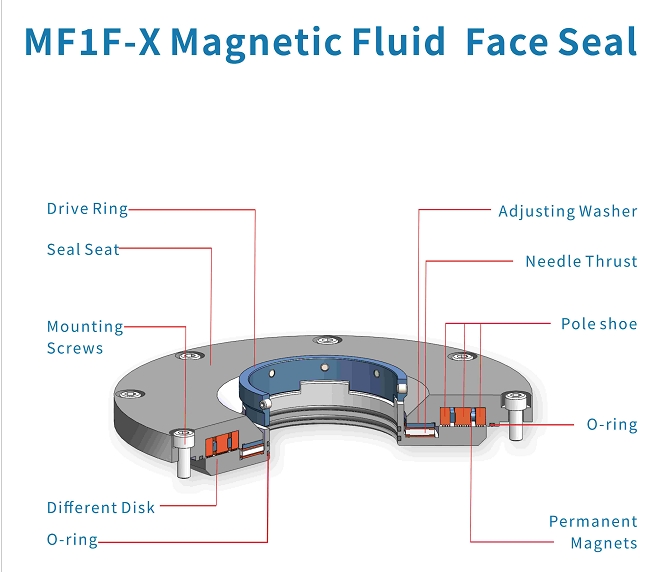Magnetic fluid face seals consist of a magnetic fluid that is held in place by a magnetic field. The magnetic fluid seal is typically formed between a rotating shaft and a stationary housing. The fluid itself contains nanoparticles of magnetic material (such as iron) suspended in a carrier liquid. When exposed to a magnetic field, these particles form a structure that can change shape but retains its volume, creating an effective seal that can adapt to minor variations in the gap or surface irregularities.

Magnetic Fluid: The key component, which is a stable colloidal suspension of magnetic nanoparticles.
Magnet: Creates a magnetic field necessary to hold and shape the ferrofluid into a sealing ring.
Pole Pieces: Typically flanking the magnet, these help shape and focus the magnetic field to maintain the integrity of the seal.
Rotating Shaft: The moving part that the seal must accommodate.
Stationary Housing: The non-moving part that encloses the rotating shaft.
High Sealing Integrity: They provide an excellent seal that can prevent even tiny particles or gases from leaking, which is crucial in vacuum environments and in applications dealing with hazardous or sensitive fluids.
Low Friction: Unlike mechanical seals, magnetic fluid seals do not require physical contact between the seal and the shaft, thus reducing friction and wear.
Operational in Extreme Conditions: Effective in environments with extreme temperatures and pressures.
Flexibility: Can accommodate misalignment and vibrations better than rigid mechanical seals.
Semiconductor Manufacturing: Used in vacuum chambers and equipment where contamination needs to be minimized.
Aerospace: In spacecrafts and satellites where reliable sealing is critical in vacuum conditions.
Hard Disk Drives: To seal the spindle motor ensuring that contaminants do not enter the drive.
Chemical Processing: In pumps handling corrosive or toxic substances where leaks can be hazardous.
Magnetic Field Interference: The magnetic fields used can interfere with other equipment or magnetic media.
Cost: Generally more expensive than traditional mechanical seals.
Compatibility: The carrier fluid needs to be compatible with the working environment to avoid chemical degradation or reaction.